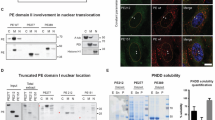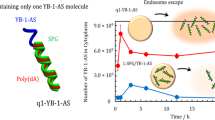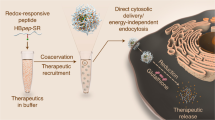Abstract
The activation of nuclear factor κB (NFκB) is a key event in immune and inflammatory responses. In this study, a cell-penetrating transport peptide, transportan (TP) or its shorter analogue TP 10, was used to facilitate the cellular uptake of an NFκB decoy. Peptide nucleic acid (PNA) hexamer or nonamer was linked to the transport peptide by a disulfide bond. NFκB decoy oligonucleotide consisted of a double-stranded consensus sequence corresponding to the κB site localized in the IL-6 gene promoter, 5′-GGGACTTTCCC-3′, with a single-stranded protruding 3′-terminal sequence complementary to the PNA sequence was hybridized to the transport peptide–PNA construct. The ability of the transport peptide–PNA–NFκB decoy complex to block the effect of interleukin (IL)-1β-induced NFκB activation and IL-6 gene expression was analyzed by electrophoretic mobility shift assay and reverse transcriptase-polymerase chain reaction in rat Rinm5F insulinoma cells. Preincubation with transport peptide–PNA–NFκB decoy (1 μM, 1 h) blocked IL-1β-induced NFκB-binding activity and significantly reduced the IL-6 mRNA expression. The same concentration of NFκB decoy in the absence of transport peptide–PNA had no effect even after longer incubations. Our results showed that binding of the oligonucleotide NFκB decoy to the nonamer PNA sequence resulted in a stable complex that was efficiently translocated across the plasma membrane.
This is a preview of subscription content, access via your institution
Access options
Subscribe to this journal
Receive 12 print issues and online access
$259.00 per year
only $21.58 per issue
Buy this article
- Purchase on Springer Link
- Instant access to full article PDF
Prices may be subject to local taxes which are calculated during checkout







Similar content being viewed by others
References
Baldwin Jr AS . The NF-kappa B and I kappa B proteins: new discoveries and insights. Annu Rev Immunol 1996; 14: 649–683.
O'Neill LA, Kaltschmidt C . NF-kappa B: a crucial transcription factor for glial and neuronal cell function. Trends Neurosci 1997; 20: 252–258.
Baeuerle PA, Baltimore D . I kappa B: a specific inhibitor of the NF-kappa B transcription factor. Science 1988; 242: 540–546.
May MJ, Ghosh S . Signal transduction through NF-kappa B. Immunol Today 1998; 19: 80–88.
Baeuerle PA, Henkel T . Function and activation of NF-kappa B in the immune system. Annu Rev Immunol 1994; 12: 141–179.
Janssen-Heininger YM, Poynter ME, Baeuerle PA . Recent advances towards understanding redox mechanisms in the activation of nuclear factor kappaB. Free Radic Biol Med 2000; 28: 1317–1327.
Pahl HL . Activators and target genes of Rel/NF-kappaB transcription factors. Oncogene 1999; 18: 6853–6866.
Regnier CH et al. Identification and characterization of an IkappaB kinase. Cell 1997; 90: 373–383.
Woronicz JD et al. IkappaB kinase-beta: NF-kappaB activation and complex formation with IkappaB kinase-alpha and NIK. Science 1997; 278: 866–869.
Burns K et al. MyD88, an adapter protein involved in interleukin-1 signaling. J Biol Chem 1998; 273: 12203–12209.
Mochida Y et al. ASK1 inhibits interleukin-1-induced NF-kappa B activity through disruption of TRAF6–TAK1 interaction. J Biol Chem 2000; 275: 32747–32752.
Ng SB, Tan YH, Guy GR . Differential induction of the interleukin-6 gene by tumor necrosis factor and interleukin-1. J Biol Chem 1994; 269: 19021–19027.
Sparacio SM, Zhang Y, Vilcek J, Benveniste EN . Cytokine regulation of interleukin-6 gene expression in astrocytes involves activation of an NF-kappa B-like nuclear protein. J Neuroimmunol 1992; 39: 231–242.
Merola M, Blanchard B, Tovey MG . The kappa B enhancer of the human interleukin-6 promoter is necessary and sufficient to confer an IL-1 beta and TNF-alpha response in transfected human cell lines: requirement for members of the C/EBP family for activity. J Interferon Cytokine Res 1996; 16: 783–798.
Khaled AR, Butfiloski EJ, Sobel ES, Schiffenbauer J . Use of phosphorothioate-modified oligodeoxynucleotides to inhibit NF-kappaB expression and lymphocyte function. Clin Immunol Immunopathol 1998; 86: 170–179.
Kwon H et al. Inducible expression of IkappaBalpha repressor mutants interferes with NF-kappaB activity and HIV-1 replication in Jurkat T cells. J Biol Chem 1998; 273: 7431–7440.
Singh S, Aggarwal BB . Activation of transcription factor NF-kappa B is suppressed by curcumin (diferuloylmethane) [corrected]. J Biol Chem 1995; 270: 24995–25000.
Singh S, Aggarwal BB . Protein-tyrosine phosphatase inhibitors block tumor necrosis factor-dependent activation of the nuclear transcription factor NF-kappa B. J Biol Chem 1995; 270: 10631–10639.
Tomita N et al. Transcription factor decoy for nuclear factor-kappaB inhibits tumor necrosis factor-alpha-induced expression of interleukin-6 and intracellular adhesion molecule-1 in endothelial cells. J Hypertens 1998; 16: 993–1000.
Tomita N et al. Transcription factor decoy for NFkappaB inhibits TNF-alpha-induced cytokine and adhesion molecule expression in vivo. Gene Therapy 2000; 7: 1326–1332.
Schmedtje JF et al. Hypoxia induces cyclooxygenase-2 via the NF-kappaB p65 transcription factor in human vascular endothelial cells. J Biol Chem 1997; 272: 601–608.
Ye SM, Johnson RW . Regulation of interleukin-6 gene expression in brain of aged mice by nuclear factor kappaB. J Neuroimmunol 2000; 117: 87–96.
Tomita T et al. Transcription factor decoy for NFkappaB inhibits cytokine and adhesion molecule expressions in synovial cells derived from rheumatoid arthritis. Rheumatology (Oxford) 2000; 39: 749–757.
Morishita R et al. In vivo transfection of cis element ‘decoy’ against nuclear factor-kappaB binding site prevents myocardial infarction. Nat Med 1997; 3: 894–899.
Ono S et al. Decoy administration of NF-kappaB into the subarachnoid space for cerebral angiopathy. Hum Gene Ther 1998; 9: 1003–1011.
Sharma HW et al. Transcription factor decoy approach to decipher the role of NF-kappa B in oncogenesis. Anticancer Res 1996; 16: 61–69.
Suzuki J et al. Decoy against nuclear factor-kappa B attenuates myocardial cell infiltration and arterial neointimal formation in murine cardiac allografts. Gene Therapy 2000; 7: 1847–1852.
Vos IH et al. NFkappaB decoy oligodeoxynucleotides reduce monocyte infiltration in renal allografts. FASEB J 2000; 14: 815–822.
Derossi D, Joliot AH, Chassaing G, Prochiantz A . The third helix of the Antennapedia homeodomain translocates through biological membranes. J Biol Chem 1994; 269: 10444–10450.
Pooga M, Hällbrink M, Zorko M, Langel Ü . Cell penetration by transportan. FASEB J 1998; 12: 67–77.
Pooga M et al. Cell penetrating PNA constructs regulate galanin receptor levels and modify pain transmission in vivo. Nat Biotechnol 1998; 16: 857–861.
Egholm M et al. PNA hybridizes to complementary oligonucleotides obeying the Watson–Crick hydrogen-bonding rules. Nature 1993; 365: 566–568.
Jensen KK, Orum H, Nielsen PE, Norden B . Kinetics for hybridization of peptide nucleic acids (PNA) with DNA and RNA studied with the BIAcore technique. Biochemistry 1997; 36: 5072–5077.
Troy CM et al. Downregulation of Cu/Zn superoxide dismutase leads to cell death via the nitric oxide–peroxynitrite pathway. J Neurosci 1996; 16: 253–261.
Griffin TJ, Smith LM . An approach to predicting the stabilities of peptide nucleic acid:DNA duplexes. Anal Biochem 1998; 260: 56–63.
Matsusaka T et al. Transcription factors NF-IL6 and NF-kappa B synergistically activate transcription of the inflammatory cytokines, interleukin 6 and interleukin 8. Proc Natl Acad Sci USA 1993; 90: 10193–10197.
Akira S et al. A nuclear factor for IL-6 expression (NF-IL6) is a member of a C/EBP family. EMBO J 1990; 9: 1897–1906.
Vanden Berghe W et al. p38 and extracellular signal-regulated kinase mitogen-activated protein kinase pathways are required for nuclear factor-kappaB p65 transactivation mediated by tumor necrosis factor. J Biol Chem 1998; 273: 3285–3290.
Vanden Berghe W et al. The nuclear factor-kappaB engages CBP/p300 and histone acetyltransferase activity for transcriptional activation of the interleukin-6 gene promoter. J Biol Chem 1999; 274: 32091–32098.
Hungness ES et al. The transcription factor activator protein-1 is activated and interleukin-6 production is increased in interleukin-1beta-stimulated human enterocytes. Shock 2000; 14: 386–391.
Libermann TA, Baltimore D . Activation of interleukin-6 gene expression through the NF-kappa B transcription factor. Mol Cell Biol 1990; 10: 2327–2334.
Sandler S et al. Decreased cell replication and polyamine content in insulin-producing cells after exposure to human interleukin 1 beta. Immunol Lett 1989; 22: 267–272.
Corbett JA et al. Interleukin 1 beta induces the formation of nitric oxide by beta-cells purified from rodent islets of Langerhans. Evidence for the beta-cell as a source and site of action of nitric oxide. J Clin Invest 1992; 90: 2384–2391.
Eikelenboom P, Zhan SS, van Gool WA, Allsop D . Inflammatory mechanisms in Alzheimer's disease. Trends Pharmacol Sci 1994; 15: 447–450.
Bauer J et al. Interleukin-6 and alpha-2-macroglobulin indicate an acute-phase state in Alzheimer's disease cortices. FEBS Lett 1991; 285: 111–114.
McGeer PL, McGeer EG . Inflammation, autotoxicity and Alzheimer disease. Neurobiol Aging 2001; 22: 799–809.
Rogers J et al. Complement activation by beta-amyloid in Alzheimer disease. Proc Natl Acad Sci USA 1992; 89: 10016–10020.
Boissiere F et al. Nuclear translocation of NF-kappaB in cholinergic neurons of patients with Alzheimer's disease. Neuroreport 1997; 8: 2849–2852.
Kitamura Y et al. Alteration of transcription factors NF-kappaB and STAT1 in Alzheimer's disease brains. Neurosci Lett 1997; 237: 17–20.
Terai K, Matsuo A, McGeer PL . Enhancement of immunoreactivity for NF-kappa B in the hippocampal formation and cerebral cortex of Alzheimer's disease. Brain Res 1996; 735: 159–168.
Strauss S et al. Detection of interleukin-6 and alpha 2-macroglobulin immunoreactivity in cortex and hippocampus of Alzheimer's disease patients. Lab Invest 1992; 66: 223–230.
Wood JA et al. Cytokine indices in Alzheimer's temporal cortex: no changes in mature IL-1 beta or IL-1RA but increases in the associated acute phase proteins IL-6, alpha 2-macroglobulin and C-reactive protein. Brain Res 1993; 629: 245–252.
Hull M et al. Interleukin-6-associated inflammatory processes in Alzheimer's disease: new therapeutic options. Neurobiol Aging 1996; 17: 795–800.
Barger SW et al. Tumor necrosis factors alpha and beta protect neurons against amyloid beta-peptide toxicity: evidence for involvement of a kappa B-binding factor and attenuation of peroxide and Ca2+ accumulation. Proc Natl Acad Sci USA 1995; 92: 9328–9332.
Taglialatela G, Robinson R, Perez-Polo JR . Inhibition of nuclear factor kappa B (NFkappaB) activity induces nerve growth factor-resistant apoptosis in PC12 cells. J Neurosci Res 1997; 47: 155–162.
Guo Q, Robinson N, Mattson MP . Secreted beta-amyloid precursor protein counteracts the proapoptotic action of mutant presenilin-1 by activation of NF-kappaB and stabilization of calcium homeostasis. J Biol Chem 1998; 273: 12341–12351.
Moerman AM, Mao X, Lucas MM, Barger SW . Characterization of a neuronal kappaB-binding factor distinct from NF-kappaB. Brain Res Mol Brain Res 1999; 67: 303–315.
Kunsch C, Ruben SM, Rosen CA . Selection of optimal kappa B/Rel DNA-binding motifs: interaction of both subunits of NF-kappa B with DNA is required for transcriptional activation. Mol Cell Biol 1992; 12: 4412–4421.
Schmid RM, Liptay S, Betts JC, Nabel GJ . Structural and functional analysis of NF-kappa B. Determinants of DNA binding specificity and protein interaction. J Biol Chem 1994; 269: 32162–32167.
Toledano MB, Ghosh D, Trinh F, Leonard WJ . N-terminal DNA-binding domains contribute to differential DNA-binding specificities of NF-kappa B p50 and p65. Mol Cell Biol 1993; 13: 852–860.
Langel Ü, Land T, Bartfai T . Design of chimeric peptide ligands to galanin receptors and substance P receptors. Int J Pept Protein Res 1992; 39: 516–522.
Egholm M, Buchart O, Nielsen PE, Berg RH . Peptide nucleic acids (PNA). Oligonucleotide analogues with an achiral peptide backbone. J Am Chem Soc 1992; 114: 1895–1897.
Gatti S, Bartfai T . Induction of tumor necrosis factor-alpha mRNA in the brain after peripheral endotoxin treatment: comparison with interleukin-1 family and interleukin-6. Brain Res 1993; 624: 291–294.
Acknowledgements
This work was supported by grants from the Swedish Research Council for Medical Science and for Natural and Engineering Sciences and EC project QLK3-CT-2002-01989.
Author information
Authors and Affiliations
Rights and permissions
About this article
Cite this article
Fisher, L., Soomets, U., Cortés Toro, V. et al. Cellular delivery of a double-stranded oligonucleotide. Gene Ther 11, 1264–1272 (2004). https://doi.org/10.1038/sj.gt.3302291
Received:
Accepted:
Published:
Issue Date:
DOI: https://doi.org/10.1038/sj.gt.3302291
Keywords
This article is cited by
-
The Correlation Between PINK-1/Parkin Mediated Mitophagy, Endoplasmic Reticulum Stress and Total Polyamines in Pediatric Bronchial Asthma: An Integrated Network of Pathways
Molecular Biology Reports (2022)
-
Modeling the therapeutic efficacy of NFκB synthetic decoy oligodeoxynucleotides (ODNs)
BMC Systems Biology (2018)
-
Effect of a Flexible Linker on Recombinant Expression of Cell-Penetrating Peptide Fusion Proteins and Their Translocation into Fungal Cells
Molecular Biotechnology (2016)
-
PNA2/DNA Triplexes: Stability and Specificity
Russian Journal of Genetics (2005)



